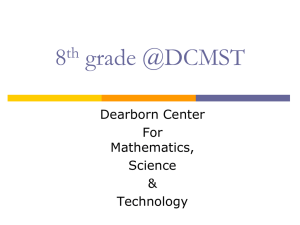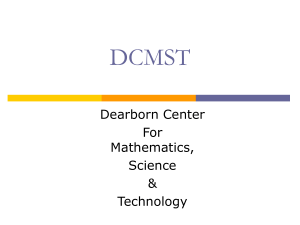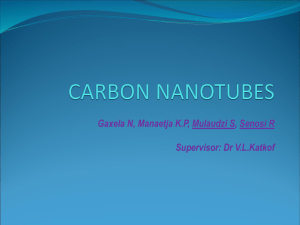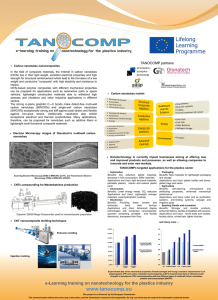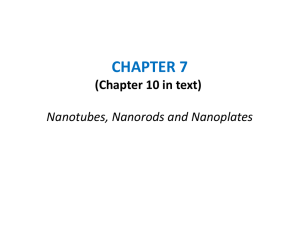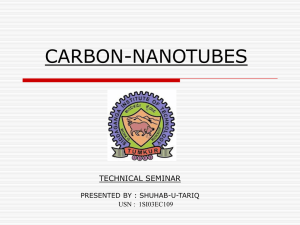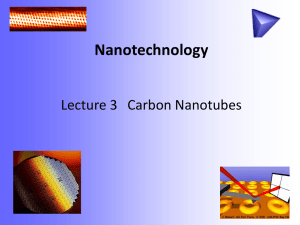PPT - Wayne State University
advertisement
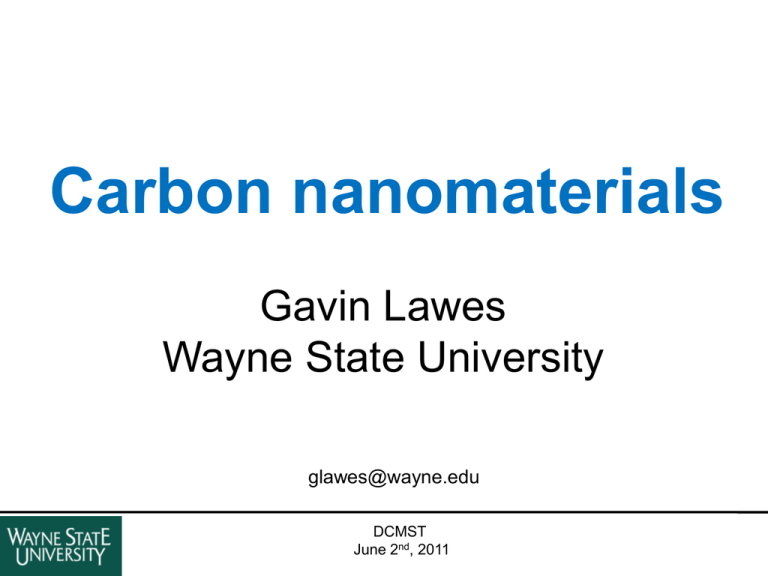
Carbon nanomaterials Gavin Lawes Wayne State University glawes@wayne.edu DCMST June 2nd, 2011 Outline 1.Carbon structures 2. Carbon nanostructures 3. Potential applications for Carbon nanostructures DCMST June 2nd, 2011 Periodic table from bpc.edu DCMST June 2nd, 2011 Carbon atom Electron (-) Proton (+) Neutron DCMST June 2nd, 2011 Carbon-based molecules are somewhat important for life on Earth… Amino acids amino group carboxylic acid group from msu.edu/gallego DCMST June 2nd, 2011 Lecithin from indiana.edu/oso Phospholipids DCMST June 2nd, 2011 …and are also important for all industrial activity Pentane from wikimedia.org DCMST June 2nd, 2011 Electron orbitals s orbital p orbital from britannica.com DCMST June 2nd, 2011 Hybridization from ASDN.net DCMST June 2nd, 2011 3 sp hybridized C crystals from diamonds.net from cnx.org DCMST June 2nd, 2011 2 sp hybridized C crystals from cochise.edu/wellerr DCMST June 2nd, 2011 Graphite consists of layers of hexagonal Carbon sheets. from chem.wisc.edu DCMST June 2nd, 2011 Diamond Graphite Electrical insulator Electrical conductor* Very hard Very soft* Transparent Opaque Expensive Cheap DCMST June 2nd, 2011 Nanoscale carbon structures DCMST June 2nd, 2011 Buckminsterfullerene Molecule consisting of 60 C atoms sp2 hybridized bonds Has 20 hexagons, 12 pentagons Other related structures have 70 or 84 C atoms from sciencedaily.com DCMST June 2nd, 2011 C60 is named for Buckminster Fuller who designed geodesic domes. from unusualife.com DCMST June 2nd, 2011 Original report of C60 DCMST June 2nd, 2011 1996 Nobel Prize in Chemistry Robert Curl, Sir Harold Kroto, Richard Smalley “for their discovery of fullerenes”. from Nobelprize.org DCMST June 2nd, 2011 Carbon nanotubes Rolled up sheet of sp2 bonded carbon atoms from informaworld.com DCMST June 2nd, 2011 Carbon nanotubes can be formed from a single sheet of C atoms or several sheets Multiwalled carbon nanotube (several sheets of carbon atoms) Single walled carbon nanotube (single sheet of carbon atoms) from rice.edu DCMST June 2nd, 2011 Carbon sheets can also be rolled up in different directions to give different types of nanotubes. DCMST June 2nd, 2011 The properties of nanotubes depend on how they are rolled up Electrical conductor Electrical insulator from phycomp.technion.ac.il DCMST June 2nd, 2011 Nanotube sizes also depend on how they are rolled up DCMST June 2nd, 2011 Graphene (single sp2 bonded carbon sheet) DCMST June 2nd, 2011 C atoms in hexagonal array from cnx.org DCMST June 2nd, 2011 From ncem.lbl.gov Scale bar 0.2 nm DCMST June 2nd, 2011 Nobel Prize in Physics 2010 Andre Geim and Konstantin Novoselov “for groundbreaking experiments regarding the two-dimensional material graphene”. from Nobelprize.org DCMST June 2nd, 2011 Carbon nanostructures DCMST June 2nd, 2011 Why are carbon nanostructures interesting? DCMST June 2nd, 2011 They are strong Multiwall carbon nanotube breaking DCMST June 2nd, 2011 Multiwall carbon nanotube composite Silica fibres +MWCNT Mechanical properties can improve by 50% or more by adding carbon nanotubes. DCMST June 2nd, 2011 Damascus sabre steel contains nanotubes Multiwalled carbon nanotubes found in 17th century sword. 10 nm These are formed during the synthesis and may have produced the very good mechanical properties. DCMST June 2nd, 2011 They have good electrical properties from bpc.edu DCMST June 2nd, 2011 Carbon nanostructures may be used in new electronic devices from nanotechweb.org DCMST June 2nd, 2011 Devices made with carbon nanotubes DCMST June 2nd, 2011 Carbon nanotubes can be used for making electronic devices Carbon Nanotubes. Advanced Topics in the Synthesis, Structure, Properties and Applications, 455-93, 2008 DCMST June 2nd, 2011 Properties of graphene depend on the subtrate from als.lbl.gov DCMST June 2nd, 2011 Geometry of graphene may also affect the properties From nanotechweb.org DCMST June 2nd, 2011 Graphene may be used as a transparent electrode DCMST June 2nd, 2011 Carbon nanotube mechanical oscillator Force sensitivity of 1 fN Hz-1/2 DCMST June 2nd, 2011 Graphene mechanical oscillator DCMST June 2nd, 2011 Carbon nanotubes may have biomedical applications Carbon nanotubes can be functionalized with different biologically relevant molecules. DCMST June 2nd, 2011 Cells incubated with functionalized carbon nanotubes DCMST June 2nd, 2011 Electronic bandgap Energy Momentum Metal Semiconductor DCMST June 2nd, 2011 The electronic bandgap for graphene looks like a pair of cones touching at their tips for certain positions (in momentum space). This leads to interesting electronic properties. from wikipedia.com DCMST June 2nd, 2011 Schrodinger Equation h 2 i V t 2m 2 2 E~p (for massive particles) Dirac Equation i i aea iA m t (for relativistic particles) E~p Appropriate for electrons in graphene DCMST June 2nd, 2011 How do you make carbon nanotubes? 1. Carbon arc discharge. Hold two carbon (graphite) electrodes at some potential difference in a Helium atmosphere and bring the electrodes together. At some separation and arc will be produced, and carbon nanotubes will grow on the cathode. These will normally be multiwalled nanotubes, but single walled nanotubes can be grown by adding Ni, Fe, or Co to the cathode. DCMST June 2nd, 2011 2. Laser ablation. Heat up a lump of graphite to ~1200 C in an Ar atmosphere, and then blast it with a laser. This can make single walled nanotubes if the graphite has a catalyst like Co or Ni included. 3. Catalytic growth. Heat up hydrocarbons (e.g. acetylene) to high temperatures and then let them settle on a substrate coated with a catalyst (Fe, Co, Ni). This will form either multiwalled nanotubes or single walled nanotubes depending on the growth conditions. How do you make graphene? Graphite and scotch tape. DCMST June 2nd, 2011 Open problems 1. To be useful for devices, these carbon nanomaterials need to be prepared on and/or connected reliably to electrodes. 2. Since the properties of these nanomaterials depend strongly on structure (e.g. armchair vs zig-zag nanotubes), we need to have good control over these structural details. 3. Many unanswered physics questions remain, including the magnetism, superconductivity, and optical properties of these materials. DCMST June 2nd, 2011 Summary 1. A number of carbon allotropes naturally form interesting nanostructures 2. These nanostructures have enormous potential in developing new electronic, optical, and nano-mechanical devices. DCMST June 2nd, 2011 End DCMST June 2nd, 2011
